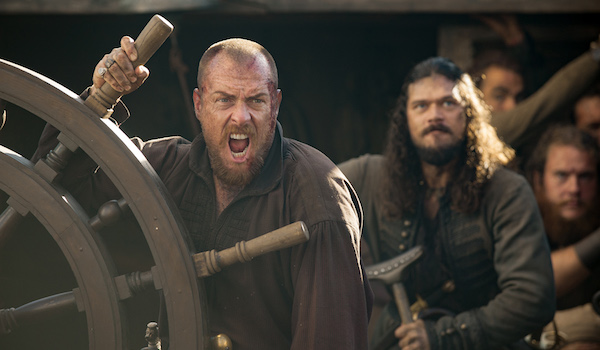TV Review: BLACK SAILS: Season 4, Episode 10: XXXVIII. [Starz]
Black Sails XXXVIII. Review
Starz‘s Black Sails: Season 4, Episode 10: XXXVIII. ended the television storylines of its classic characters in ways that the viewer, he or she that had not read Robert Louis Stevenson‘s Treasure Island, never saw coming.
Unlike every other episode in the series, the beginning to XXXVIII. did not begin with crashing music over sculpted war imagery as credits rolled past. They were supplanted, momentarily, by a fascinating monologue given by a new American character on society and its “undesirables.”
Deviating from other momentous Black Sails episode openings with battle scenes, etc., XXXVIII. began and ended with narrative substance. The latter, however, was weaker than the viewer would have liked.
Captain Jack Rackham (Toby Schmitz) and Featherstone (Craig Jackson)’s arrival in XXXVIII. ended, in short order, what the viewer had been expecting to happen between Governor Woodes Rogers (Luke Roberts)’s men and what was left of Captain James Flint (Toby Stephens)’s crew. Though brief, the scene did, however, show how far Woodes Rogers’ transmogrification had progressed when he gave the sine missione order.
There were many times throughout Black Sails where Captain Flint proved he could be just as clever as Quartermaster “Long” John Silver (Luke Arnold). When Flint created a plan on the fly in XXXVIII. to save Madi (Zethu Dlomo) while simultaneously putting her in the least amount of danger, it surprised even Silver, especially after Flint had been so ready to sacrifice her for the Urca de Lima treasure. Flint’s rescue plan stemmed from the point-of-view of someone that had gotten what they wanted i.e. the treasure and the war it would fund. Flint then wanted to give Silver back what Silver wanted there by regaining Silver’s friendship and their partnership.
Quartermaster Silver’s plans were to the contrary. Silver had underestimated Flint once and nearly lost Madi in the process. He had no intention of doing so again, even with Flint’s friendly platitudes and willingness to forgive and forget. Max (Jessica Parker Kennedy) and William “Billy Bones” Manderly (Tom Hopper) had planted a seed in Quartermaster Silver’s mind in Nassau, a seed that sprouted unexpected and life-altering fruit during XXXVIII.
As everyone knew, Long John Silver was a person capable of thinking multiple moves ahead of his opponent. I do not believe anyone knew, however, how far into the future he could actually think or how devious and devilish he could be. Like Israel Hands said in XXXVII., Silver had learned a lot from Captain Flint. That, in connection with Silver’s raw intelligence, allowed him to out maneuver his most important adversary. Silver had been fashioning Flint’s end for some time.
Silver’s eventual decision about Flint and the war that Flint, Madi, and The Maroon Queen wanted was not unexpected because of the groundwork laid for it in previous episodes. What was completely unexpected was the result of Silver and Flint’s final interaction. There are an infinitesimal few who are sent to the hot, biting flames of a plantational-hell with quite resolve and dignity. Captain Flint did so. Flint’s “retirement” was bittersweet, where desires and dreams emerged from the past to be embraced, within a gilded cage of the present.
The fight scene between Captain Flint and Billy Bones, earlier in the episode, atop a ship mast was the most ambitious and cinematic moment in XXXVIII. (the camera slowly zoomed in on the fisticuffs). The mutual hatred between the two of them was palpable as each gained and lost the upper-hand on the other. The scene ended in a familiar way for Bones and sentenced him to a solitary prison that he had chosen in XXXVII. It was ironic that Bones physically ended up where the tide of his ambitions had previously delivered him mentally – abandoned, isolated, and alone.
Ruthless Governor Woodes Rogers’ ignominious end was partially of his own making, though he did fight like hell (two opponents coterminous) to avoid it in XXXVIII. “When you dance with the devil, the devil doesn’t change. The devil changes you.” By the end of Governor Rogers’ dance, Rogers was on his knees, in the same position Blackbeard had been in during XXXI. As he stood shackled and history was written before his eyes, a history that he no longer had a hand in writing, the viewer could only imagine what was going through Governor Rogers’ mind. His ambitions lay in ruins, his wife and unborn child were dead, and his previous wife hated him. And unlike Captain Jack Rackham, who gloated in the shadows at Rogers’ defeat, Rogers would not be able to escape the debt and the reputation now permanently affixed to his name.
The ending to Black Sails was satisfying when it came to Captain Flint but unsatisfying as a whole (but in no way as bad as Battlestar Galactica‘s ending or as terrible as Dexter‘s last episode). The viewer just wanted more from Black Sails‘ ending. That need, that expectation came from the high-bar Black Sail had set for itself when it came to its narrative. The viewer wanted the story to end with a bang. Instead, it ended with two inseparable friends on-deck speaking about Flint’s treasure, a notorious flag (was that the flag Charlotte designed in Season 2?), and a particular new crewman.
When the viewer watched the ending two scenes of XXXVIII., a chunk of time was devoted to that new crewman, a very interesting and unique character. Introduced as Mark Read, Read’s appearance was peculiar for the start. It was all in the eyes. “He” had a woman’s eyes. Even male models, men paid by fashion companies because of the symmetry of their faces, don’t have eyes like that. I may be wrong, though I have previously seen women playing men on TV and in film e.g. Pitch Black, The Borgias, Shakespeare in Love. I wonder why that choice was made in XXXVIII. I have not read Treasure Island yet (I will probably start reading it next week – no spoilers in the comment section please), so I don’t know if a woman dressed as a man plays a part in that narrative.
Or was the person who auditioned for the Mark Read part so good (they were) the producers of Black Sails decided to give them the part, regardless of their gender? Either way, the viewer was intrigued. Intrigued enough to watch Read’s two scenes multiple times. “He” pulled off the part completely. If it wasn’t for the eyes, I never would have known. “He” had down cold the voice, hair style, stance, and swagger of a grimy buccaneer.
There are not many TV series that conclude by enticing the viewer, inducing them into wanting more. Black Sails did so, thanks to that flag, Long John Silver, Billy Bones, Mark Read, and the mystique of Captain Flint. The best part of the ending was that it was just the beginning. The story was not over. It’s time to read Treasure Island.
Leave your thoughts on this Black Sails XXXVIII. review and this episode of Black Sails below in the comments section. Readers seeking more Black Sails can visit our Black Sails Page and our Black Sails Google+ Page. Readers seeking more TV show reviews can visit our TV Show Review Page, our TV Show Review Twitter Page, our TV Show Review Facebook Page, and our TV Show Review Google+ Page. Want up-to-the-minute notification? FilmBook staff members publish articles by Email, Twitter, Tumblr, Google+, and Facebook.
Related Articles
FilmBook's Newsletter
Subscribe to FilmBook’s Daily Newsletter for the latest news!













